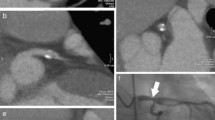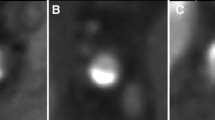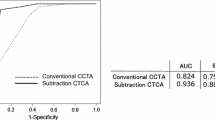Abstract
Objective To analyze the diagnostic efficacy of computer aided analysis of relevant coronary artery stenosis using dual source computed tomography (DSCT). Methods In a larger scale study patients scheduled for conventional coronary angiography (CA) were additionally examined with DSCT. Based on a 13-segment model 30 CT scans of this study population were analyzed for significant stenosis using conventional 3D charts (3D) as well as a specialized cardiac analysis tool (CAT). Diagnostic accuracy and time to diagnosis was recorded for each vessel separately as well as the three readers’ confidence. Results With severe coronary artery calcifications, 53 false interpretations of segments were found for the total of 390 coronary segments analyzed. 3D and CAT analysis showed a Sensitivity, Specificity, PPV and NPV of 0.59, 0.91, 0.57, 0.92 and 0.57, 0.92, 0.56, 0.92, respectively. No significant differences in diagnostic accuracy could be found between 3D and CAT (P = 0.1667). 3D took a mean of 5.2 min (3–10 min). With CAT a mean time of 8.2 min (4–12 min) was needed. No significant inter-reader time differences (P = 0.4954) and no significant confidence level differences were found between readers and analyzes. Conclusion CAT of the coronary tree shows comparable accuracy to manual 3D analysis but needs improvements concerning coronary tree segmentation times.






Similar content being viewed by others
References
Lawler LP, Pannu HK, Fishman EK (2005) MDCT evaluation of the coronary arteries, 2004: how we do it—data acquisition, postprocessing, display, and interpretation. AJR Am J Roentgenol 184(5):1402–1412
Budoff MJ, Gopal A, Gopalakrishnan D (2006) Cardiac computed tomography: diagnostic utility and integration in clinical practice. Clin Cardiol 29(9):I4–I14
Schoenhagen P, Halliburton SS, Stillman AE, Kuzmiak SA, Nissen SE, Tuzcu EM et al (2004) Noninvasive imaging of coronary arteries: current and future role of multi-detector row CT. Radiology 232(1):7–17. doi:10.1148/radiol.2321021803
Brown MS, McNitt-Gray MF, Pais R, Shah SK, Qing P, Da Coasta I et al (2007) CAD in clinical trials: current role and architectural requirements. Comput Med Imaging Graph 31(4–5):332–337. doi:10.1016/j.compmedimag.2007.02.014
Doi K (2007) Computer-aided diagnosis in medical imaging: historical review, current status and future potential. Comput Med Imaging Graph 31(4–5):198–211. doi:10.1016/j.compmedimag.2007.02.002
Katsuragawa S, Doi K (2007) Computer-aided diagnosis in chest radiography. Comput Med Imaging Graph 31(4–5):212–223. doi:10.1016/j.compmedimag.2007.02.003
Marten K, Engelke C (2007) Computer-aided detection and automated CT volumetry of pulmonary nodules. Eur Radiol 17(4):888–901. doi:10.1007/s00330-006-0410-3
Mougiakakou SG, Golemati S, Gousias I, Nicolaides AN, Nikita KS (2007) Computer-aided diagnosis of carotid atherosclerosis based on ultrasound image statistics, laws’ texture and neural networks. Ultrasound Med Biol 33(1):26–36. doi:10.1016/j.ultrasmedbio.2006.07.032
Yoshida H, Nappi J (2007) CAD in CT colonography without and with oral contrast agents: progress and challenges. Comput Med Imaging Graph 31(4–5):267–284. doi:10.1016/j.compmedimag.2007.02.011
Bogoni L, Cathier P, Dundar M, Jerebko A, Lakare S, Liang J et al (2005) Computer-aided detection (CAD) for CT colonography: a tool to address a growing need. Br J Radiol 78(Spec No 1):S57–S62
Hirai T, Korogi Y, Arimura H, Katsuragawa S, Kitajima M, Yamura M et al (2005) Intracranial aneurysms at MR angiography: effect of computer-aided diagnosis on radiologists’ detection performance. Radiology 237(2):605–610. doi:10.1148/radiol.2372041734
Busch S, Johnson TR, Nikolaou K, von Ziegler F, Knez A, Reiser MF et al (2007) Visual and automatic grading of coronary artery stenoses with 64-slice CT angiography in reference to invasive angiography. Eur Radiol 17(6):1445–1451. doi:10.1007/s00330-006-0512-y
Flohr TG, McCollough CH, Bruder H, Petersilka M, Gruber K, Suss C et al (2006) First performance evaluation of a dual-source CT (DSCT) system. Eur Radiol 16(2):256–268. doi:10.1007/s00330-005-2919-2
Boskamp T, Rinck D, Link F, Kummerlen B, Stamm G, Mildenberger P (2004) New vessel analysis tool for morphometric quantification and visualization of vessels in CT and MR imaging data sets. Radiographics 24(1):287–297. doi:10.1148/rg.241035073
Dewey M, Schnapauff D, Laule M, Lembcke A, Borges AC, Rutsch W et al (2004) Multislice CT coronary angiography: evaluation of an automatic vessel detection tool. Rofo 176(4):478–483
Keller D, Wildermuth S, Boehm T, Boskamp T, Mayer D, Schuster HL et al (2006) CT angiography of peripheral arterial bypass grafts: accuracy and time-effectiveness of quantitative image analysis with an automated software tool. Acad Radiol 13(5):610–620. doi:10.1016/j.acra.2006.01.008
Burling D, Halligan S, Roddie ME, McQuillan J, Honeyfield L, Amin H et al (2005) Computed tomography colonography: automated diameter and volume measurement of colonic polyps compared with a manual technique–in vitro study. J Comput Assist Tomogr 29(3):387–393. doi:10.1097/01.rct.0000160985.66259.96
Heussel CP, Achenbach T, Buschsieweke C, Kuhnigk J, Weinheimer O, Hammer G et al (2006) Quantification of pulmonary emphysema in multislice-CT using different software tools. Rofo 178(10):987–998
Cordeiro MA, Lardo AC, Brito MS, Rosario Neto MA, Siqueira MH, Parga JR et al (2006) CT angiography in highly calcified arteries: 2D manual vs. modified automated 3D approach to identify coronary stenoses. Int J Cardiovasc Imaging 22(3-4):507–516. doi:10.1007/s10554-005-9044-9
Mühlenbruch G, Das M, Hohl C, Wildberger JE, Rinck D, Flohr TG et al (2006) Global left ventricular function in cardiac CT. Evaluation of an automated 3D region-growing segmentation algorithm. Eur Radiol 5(16):1117–1123. doi:10.1007/s00330-005-0079-z
Taylor SA, Halligan S, Slater A, Goh V, Burling DN, Roddie ME et al (2006) Polyp detection with CT colonography: primary 3D endoluminal analysis versus primary 2D transverse analysis with computer-assisted reader software. Radiology 239(3):759–767. doi:10.1148/radiol.2392050483
Marquering HA, Dijkstra J, de Koning PJ, Stoel BC, Reiber JH (2005) Towards quantitative analysis of coronary CTA. Int J Cardiovasc Imaging 21(1):73–84. doi:10.1007/s10554-004-5341-y
Valverde FL, Guil N, Munoz J (2004) Segmentation of vessels from mammograms using a deformable model. Comput Methods Programs Biomed 73(3):233–247. doi:10.1016/S0169-2607(03)00043-9
Fishman EK, Ney DR, Heath DG, Corl FM, Horton KM, Johnson PT (2006) Volume rendering versus maximum intensity projection in CT angiography: what works best, when, and why. Radiographics 26(3):905–922. doi:10.1148/rg.263055186
Soto JA, Lucey BC, Stuhlfaut JW, Varghese JC (2005) Use of 3D imaging in CT of the acute trauma patient: impact of a PACS-based software package. Emerg Radiol 11(3):173–176. doi:10.1007/s10140-004-0384-x
Lado MJ, Cadarso-Suarez C, Roca-Pardinas J, Tahoces PG (2006) Using generalized additive models for construction of nonlinear classifiers in computer-aided diagnosis systems. IEEE Trans Inf Technol Biomed 10(2):246–253. doi:10.1109/TITB.2005.859892
Achenbach S (2005) Current and future status on cardiac computed tomography imaging for diagnosis and risk stratification. J Nucl Cardiol 12(6):703–713. doi:10.1016/j.nuclcard.2005.09.001
van Ooijen PM, Ho KY, Dorgelo J, Oudkerk M (2003) Coronary artery imaging with multidetector CT: visualization issues. Radiographics 23(6):e16. doi:10.1148/rg.e16
Farag AA, El Baz A, Gimelfarb G, El Ghar MA, Eldiasty T (2005) Quantitative nodule detection in low dose chest CT scans: new template modeling and evaluation for CAD system design. Med Image Comput Comput Assist Interv Int Conf Med Image Comput Comput Assist Interv 8(Pt 1):720–728
Juchems MS, Fleiter TR, Pauls S, Schmidt SA, Brambs HJ, Aschoff AJ (2006) CT colonography: comparison of a colon dissection display versus 3D endoluminal view for the detection of polyps. Eur Radiol 16(1):68–72. doi:10.1007/s00330-005-2805-y
Author information
Authors and Affiliations
Corresponding author
Rights and permissions
About this article
Cite this article
Reimann, A.J., Tsiflikas, I., Brodoefel, H. et al. Efficacy of computer aided analysis in detection of significant coronary artery stenosis in cardiac using dual source computed tomography. Int J Cardiovasc Imaging 25, 195–203 (2009). https://doi.org/10.1007/s10554-008-9372-7
Received:
Accepted:
Published:
Issue Date:
DOI: https://doi.org/10.1007/s10554-008-9372-7




